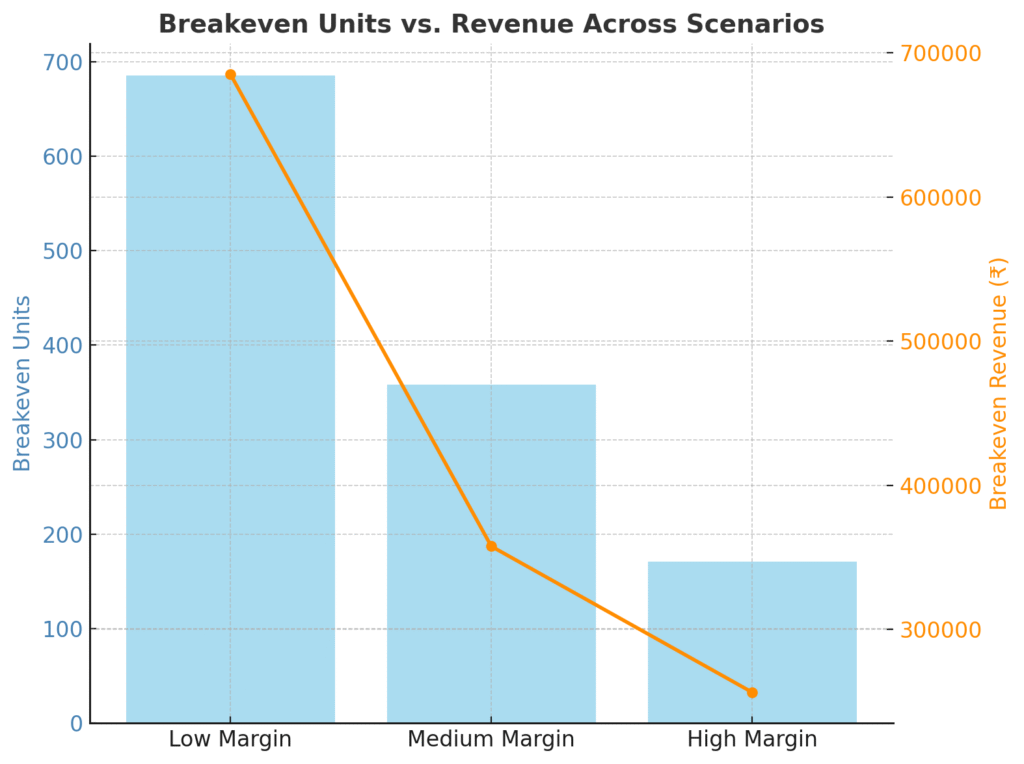Table Of Content
- Why Every E-Commerce Founder Needs a Breakeven Calculator
- Breakeven Calculator for E-Commerce Stores
- Breakeven Units
- Breakeven Revenue (₹)
- Contribution Margin per Unit (₹)
- Estimated Profit at Target Units (₹)
- What Is Breakeven Analysis in E-Commerce?
- Why Is the Breakeven Point Critical for Online Stores?
- How the Breakeven Calculator Works
- Example
- Common Mistakes Founders Make in Breakeven Analysis
- Strategic Ways to Lower Your Breakeven Point
- Breakeven Analysis vs. Profit Margin Analysis
- When Should You Use a Breakeven Calculator?
- Tools & Resources for E-Commerce Founders
- FAQs
Why Every E-Commerce Founder Needs a Breakeven Calculator
Running an e-commerce store often feels like a race to chase orders, offer discounts, and outbid competitors on ads. But what many founders forget is this: sales volume alone doesn’t equal success.
If you don’t know your breakeven point — the exact number of units or revenue required to cover all costs — you’re flying blind.
That’s why we built this free Breakeven Calculator for E-Commerce Stores. With just a few inputs — fixed costs, per-unit costs, shipping, and selling price — you can instantly discover:
- How many units you need to sell to cover your costs.
- How much revenue you need to hit breakeven.
- Your contribution margin per unit.
- Whether your current pricing strategy is sustainable.
This calculator is designed for e-commerce founders who want clarity, control, and confidence before scaling campaigns or launching new products.
Try the calculator right below.
Breakeven Calculator for E-Commerce Stores
Find the minimum units and revenue you must sell to cover costs. Factor fixed costs, per-unit variable costs, shipping and fees.
What Is Breakeven Analysis in E-Commerce?

Breakeven analysis is a financial calculation that helps you identify the point at which your total revenue equals your total costs. At this stage, your business is neither making profit nor loss.
In simple terms:
- Below breakeven = you’re losing money.
- At breakeven = you’ve covered all costs, but earned no profit yet.
- Above breakeven = every sale adds to profit.
For e-commerce businesses, breakeven analysis becomes more complex because of hidden costs like shipping, packaging, returns, payment gateway charges, and platform commissions. Without factoring these in, many founders mistakenly assume they’re profitable.
Why Is the Breakeven Point Critical for Online Stores?
Knowing your breakeven point helps you:
- Price Products Accurately
Instead of relying on “gut feeling,” you can set selling prices that cover all costs and still leave a profit margin. - Plan Promotions Safely
Discounts and free shipping can eat into margins. Breakeven analysis tells you how low you can go without destroying profitability. - Forecast Revenue Targets
If your monthly fixed costs are ₹1,50,000 and your contribution margin per unit is ₹400, you know you need 375 units to breakeven. Anything above is profit. - Negotiate Better with Suppliers
When you know your breakeven contribution margin, you can push for lower COGS or shipping costs to reduce breakeven volume.
How the Breakeven Calculator Works
Our breakeven calculator for e-commerce takes the following inputs:
- Fixed Costs (₹): Expenses that don’t change with sales volume — rent, salaries, software subscriptions.
- Price per Unit (₹): Your selling price to customers.
- Variable Cost per Unit (₹): Cost of goods sold (COGS), packaging, raw material.
- Shipping & Handling (₹): Per-unit logistics costs.
- Other Fees (₹): Marketplace commission, GST, payment gateway fees.
- Target Units (optional): Number of units you plan to sell, to project profit beyond breakeven.
It then calculates:
- Contribution per Unit = Price − (Variable Cost + Shipping + Other Fees).
- Breakeven Units = Fixed Costs ÷ Contribution per Unit.
- Breakeven Revenue (₹) = Breakeven Units × Price.
- Profit at Target Units = (Contribution × Target Units) − Fixed Costs.
Example
- Fixed Costs = ₹1,50,000
- Selling Price = ₹999
- Variable Cost = ₹450
- Shipping = ₹80
- Other Fees = ₹50
- Contribution per Unit = 999 − (450 + 80 + 50) = ₹419
- Breakeven Units = 1,50,000 ÷ 419 ≈ 358 units
- Breakeven Revenue = 358 × 999 ≈ ₹3,57,642
This means your store needs to sell at least 358 units in a month to cover costs. Everything above that is profit.
Common Mistakes Founders Make in Breakeven Analysis
- Ignoring returns and refunds
If your return rate is 10%, your breakeven volume must be adjusted upward. - Not including marketing spend
Fixed costs often exclude ad spend, but in e-commerce, customer acquisition costs are critical. - Overestimating contribution margins
Founders sometimes forget platform fees, payment gateway charges, and GST. - Confusing revenue with profit
A ₹10 lakh sales month sounds good, but if your breakeven revenue is ₹9.5 lakh, your actual profit margin is razor-thin.
Strategic Ways to Lower Your Breakeven Point
Lowering your breakeven point makes profitability easier to achieve. Here’s how:
- Negotiate supplier costs to reduce COGS.
- Optimize logistics — bulk shipping rates or regional warehouses.
- Improve contribution margin with bundles or upselling.
- Control fixed costs — switch to leaner SaaS tools, outsource selectively.
- Boost conversion rates — higher conversions reduce ad spend per sale, improving overall unit economics.
Breakeven Analysis vs. Profit Margin Analysis
While breakeven tells you when you stop losing money, profit margin tells you how much you keep after costs.
- Breakeven Calculator: “How many units/revenue do I need to stop losing money?”
- Profit Margin Calculator: “What percentage of each sale is profit?”
For complete clarity, founders should use both tools regularly.
Try our Discount & Profit Margin Calculator alongside this breakeven calculator.
When Should You Use a Breakeven Calculator?
- Before launching a new product — test if the pricing covers costs.
- When scaling ads — ensure customer acquisition cost doesn’t push you beyond breakeven.
- While planning discounts — check how reduced prices affect breakeven units.
- During fundraising — investors expect you to know your breakeven metrics.
Tools & Resources for E-Commerce Founders
- E-Commerce Pricing Strategies (Shopify Blog): Read here – a practical guide to setting profitable prices.
- Strategic Advisory Services for Founders: Explore here – for personalized help with pricing models, fundraising decks, and growth strategies.
These resources combine strategic insights with hands-on calculators, giving founders both clarity and actionable steps.
FAQs
It’s a tool that helps online store owners determine the exact number of units or revenue required to cover all fixed and variable costs.
It ensures you don’t scale at a loss. Many stores chase sales without realizing they haven’t crossed breakeven.
Fixed costs (rent, salaries, SaaS tools), variable costs (COGS), shipping, fees, commissions, and returns.
By lowering costs, improving contribution margins, optimizing logistics, and controlling overheads.
Monthly is standard for cash flow tracking, but yearly helps with strategic planning and fundraising.




